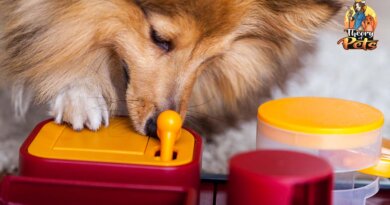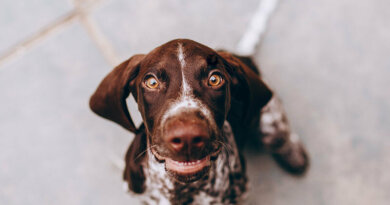Top 5 Non-Sporting Dog Breeds – Top Dog Tips
[ad_1]
In the past, dogs used to be categorized based on their purpose and the value they provided.
They were divided based on services such as hunting, guarding, and herding. As time went on, the demand for this assistance diminished.
Unable to fit into any category anymore, these dogs began to be called non-sporting or companion dogs.
They are dogs with a wide variety of sizes and characteristics that do not fit in any box. They’re merely wanted for themselves.
They have a separate division in dog shows that allow maximum variety and distinction! Check out this YouTube video of the National Dog Show 2022 for the non-sporting group:
In this article, we’ll discuss the top 5 non-sporting dog breeds and some of the factors to consider when getting one.
We’re here to help you make the best choice based on your lifestyle.
So, without further ado, let’s enter the amazing world of non-sporting dogs!
Top 5 Non-Sporting Dog Breeds
Bred for specific purposes, non-sporting dogs still maintain some of the personality they were initially needed for.
So, whether you’re looking for a watchdog, house dog, or just a cuddle buddy, they can help cater to your specific needs.
Here is our list of the top 5 non-sporting dog breeds to help you enhance your quality of life. They are loving and loyal companions that will be a worthy addition to your family!

1. Bichon Frise
Bichon Frise is an adorable purebred that has persisted through time with its bewitching looks, loveable smile, and playful nature.
Standing at about 9.5-11.5 inches and weighing around 12 to 18 pounds, these are endearing creatures that are well-suited to apartment life.
They can even serve as watchdogs if trained. But they might be too open with their affection.
To a Bichon Frise, no stranger is a stranger. All people and dogs are potential best friends, and they’ll leave no opportunity to connect with anyone!
With white royal fur falling over their small, beady eyes, they look more like a kid’s toy. Not to mention the black leather nose that only enhances their soft and supple features.
And unsurprisingly, these family-friendly dogs can be patient with little kids and their silly pranks.
They’re great for anyone looking for a hairy cuddle baby while also suffering from allergies.
With their hypoallergenic coat, they have little to no shedding. These adorable companions are unlikely to trigger any allergic reactions.
But you will have to work on maintaining this breed’s curls. Since the length of their coat is usually long, you’ll have to get it trimmed—if needed—which may be an additional cost.
This will probably not feel like much once you get used to the cute aggression every time you play with this adorable and energetic fun-sized doggo.

2. Keeshond
Friendly, lively, and outgoing, Keeshonds are definitely must-have non-sporting dogs if you’re looking for a companion that is equally affectionate and loving with children and other pets.
Treating the world as their best friend, Keeshonds have an openness that will make you feel like you belong. Their vibrant aura will always make your day brighter.
With higher-than-average energy levels, you’ll need toys and other physical activities to keep your Keeshond busy. All that pent-up stamina and power needs to go somewhere.
Its adaptable and easygoing nature means you’ll be able to teach your Keeshond loads of games and tricks.
Your canine companion—in its need to please you—will be tolerant toward everything you teach.
It is also worth noting that Keeshonds can be more vocally expressive than most dogs. This may count as an advantage or disadvantage, depending on your lifestyle.
If you live in a quiet neighborhood, it may not be received well by those around you.
While there is no disadvantage to this intelligent medium-sized dog, its fur’s shedding and grooming may be a concern for some.
The long double coat that a Keeshond boasts, which is adorable and cuddly, has moderate shedding that may trigger people with allergies.
This breed is not hypoallergenic. We do not recommend it to people with skin sensitivity or allergies.
You’ll also have to be mindful of the cost of grooming its thick and luscious coat.

3. Shiba Inu
If you’re an avid internet surfer, you might have come across a dog meme with innocent yet mischievous facial features.
This popular meme-turned-coin represents the alert, attentive, and focused personality of the dog breed known as Shiba Inu.
With a life expectancy of 13 to 16 years, this charming dog’s height and weight vary depending on gender.
While males may stand at about 14.5-16.5 inches tall, their female counterparts are slightly shorter at about 13.5-15.5.
As for their weight, the average male Shiba Inu is about 23 pounds, whereas the females tend to be around 17 pounds.
This medium-sized dog is highly trainable and adaptable, making them great companions for living in an apartment.
Although they are considered easy to tackle by experts, they can give new owners with minimal experience a tougher time.
Owing to their stubborn, independent, and opinionated nature, they have tendencies to attack—in the form of biting or general aggression—if forced to do something they do not like.
We do not recommend them to people with children. Impatient by nature, the noise and playfulness of children may trigger them and be detrimental to people with families.
But they are an ideal fit for adults who don’t mind giving them the space and attention they need.
As far as shedding is concerned, they have a short double coat with moderate levels of shedding.
They are not hypoallergenic and people with sensitive skin, breathing problems, or other allergies should be careful.

4. Schipperke
Standing 13 inches tall, this curious, enthusiastic, and confident dog was a rat-catching machine during the Black Death.
This dog breed is a popular choice for people with limited space in their homes.
Serving as rat-catchers and watchdogs on canal barges, they soon earned the nickname “Little Captain” and “Little Skipper”.
While they may have lost their initial purpose, their protective instincts remain. Barking every time they encounter a stranger, be it a human or another dog.
They’ll be sure to alert you to all potential intruders.
While they’re too small to be considered effective guard dogs, they retain their efficacy as incredible watchdogs.
There is no need to fear when your little Schipperke is still at home, cautioning you against all harm.
While not friendly with unfamiliar people (owing to their original purpose and ancestry), they’re very playful and affectionate with people and animals they know.
They’re a suitable choice for anyone with babies and kids. Cordial enough with those they love and watchful enough with strangers, they’ll be sure to offer love and protection.
The Schipperke has a short double coat with moderate shedding.
This means it’s a good choice if you’re looking to save money on grooming needs. They’re low maintenance in that regard.
But they are not hypoallergenic. This is a big no-no for people with allergies.
If you’re one of them, we urge you to look for other mixed-breed hypoallergenic alternatives for a healthier yet loving home environment.

5. Finnish Spitz
An ancient breed primarily used for hunting birds and pulling sleds, the Finnish Spitz is a good-natured and lively companion.
Most known for their barking behavior, these dogs will alert you against all potential harm and intrusion.
Loyal and playful with people they know, they make excellent pets that are equally patient with children. This makes them an excellent addition to families with babies and children.
Much like Schipperkes, they are affectionate friends with those they know and very suspicious of strangers.
These medium-sized hunters also serve as effective watchdogs. With their high adaptability, you can also train them for other games and tricks, increasing the liveliness of your home.
Their sweet-natured affection will wear your exhaustion away as you look forward to them after a long day at work.
But their high energy levels and increased need for stimulation also mean longer walks and play sessions. This may be an advantage or a disadvantage, depending on your lifestyle.
If your schedule allows the free time to go out for adventurous jogs and runs, the Finnish Spitz will be an equally competent companion for exploring different regions.
But watch out for other animals in the neighborhood. Their inquisitive nature increases their susceptibility to running after other animals instead of staying beside you.
As far as their coat is concerned, they have a double medium coat with a moderate amount of shedding.
While there may not be excessive grooming needs, they are also not hypoallergenic which may mean allergic reactions for some individuals.
Apart from shedding, their lively nature and adorable fox-like features will melt the hearts of all who encounter them!
Factors To Consider When Getting a Non-Sporting Dog Breed
Whether you’re looking for a watchdog for safety or a cuddly canine to hug, there are various factors to consider before settling on your final decision.
While no dog is inherently good or bad, it is wiser to choose one that is easily adjustable to your lifestyle.
Below we have compiled a list of 5 factors to assist you when choosing your ideal pet:
1. Size
The available space in your home will determine the size of the dog you should go for.
Large breeds such as Golden Retrievers, Labrador Retrievers, and Irish Setters will not be suitable for small studio apartments.
Small sporting breeds such as American Water Spaniels, English Cocker Spaniels, and Curly-coated Retrievers are better options if you have limited space.
2. Personality
The character and temperament of a dog are important, especially for owners with children.
You’ll have to think of traits such as friendliness, aggression, and patience with children.
Make sure to talk to the organization or individual you’re getting your dog from. Ask them about the dog’s history and habits.
3. Energy Level
A dog’s energy level should sync with yours for compatibility. If you live a busy lifestyle you will not have time to take an active doggo on walks.
This will cause trouble when the dog finds other ways to release pent-up frustration.
This can also be an ideal fit for anyone with the lifestyle to accommodate and match the dog’s needs. It all boils down to you and your requirements when choosing a companion.
4. Grooming Needs
Dogs with long hair or fur usually mean additional costs spent on their grooming needs. This is not only essential for their aesthetic appeal but also for their overall health.
Large amounts of shedding will also be a concern especially if you have allergies.
We recommend looking at the dog’s grooming needs and your budget to learn if it’s a good fit. If shedding is a concern, we recommend you look for hypoallergenic dog breeds.
5. Health Concerns
Every dog has unique genetics that makes them vulnerable to specific medical concerns.
For example, as adorable as a Bichon Frise may be, you’ll have to watch out for their susceptibility to viral and bacterial infections.
Again, this area targets your time to go to the vet and potential costs.
Search for common health concerns of the breed you want and ask yourself if you’ll be able to stay on top of regular health checkups.
Non-Sporting Dog Breeds: Final Word
Non-sporting dogs are loyal, friendly, and watchful companions.
They cater to social needs and caution against potential harm and intrusions. This means love and protection from the same adorable pet.
Make sure to follow our checklist before settling your final decision. No dog is good or bad, it’s all about compatibility with the life you live.
If you have any questions, feel free to ask us in the comments below.
READ NEXT: Working Dog Breeds: 10 Best Hardworking Canines
[ad_2]
Source link




